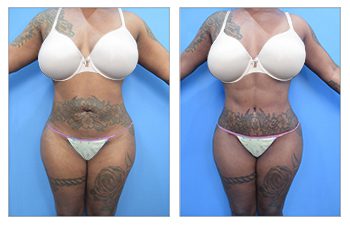Introduction: What is ex-vivo Liposuction?
Ex-Vivo Liposuction™ (outside the body) is a novel technique wherein tissues preoperatively planned for excision (removal) can be liposuctioned in a sterile manner after removal from the patient. Excised tissues are routinely obtained during a tummy tuck, lateral thigh tuck, buttock tuck, brachioplasty, upper body tuck, and even medial thigh tuck.
These tucking procedures are performed when moderate to severe skin redundancy is present in patients undergoing body contouring.
Traditionally, these tissues were first liposuctioned while attached to the patient before excising, termed in-vivo liposuction. However, we have developed ex-vivo liposuction protocols wherein the tissues are liposuctioned only after being excised off the patient. This novel approach to liposuction provides several advantages.

Advantages to performing ex vivo liposuction
- Saves operative time.
- Safer
- Less blood loss
- Less fluid shift consequences
- Less risk of vital structure injury
- Improved quality of harvested fat
- Increase maximum fat harvest volumes
- Teaching tool
Ex-vivo liposuction saves operative time
Ex-vivo liposuction saves operative time since any excised tissues can be liposuctioned simultaneously while the excised defects are repaired. When performing excision of multiple areas, such as a total body lift, the length of operation can be a detriment to patient safety.
We strive to limit operative times to less than six hours in an outpatient setting. We routinely save 1 to 2 hours of surgical time when performing ex-vivo liposuction in our total body lifts.
For example, when we perform liposuction of the flanks, the fat can be laden in dense connective tissue requiring at least one hour of liposuction to remove fat comprehensively.
Ex-vivo liposuction is safer
It is safer because the process of liposuction can cause unintentional harm to vital structures. This is especially true when performing liposuction of areas that possess a higher density of connective tissues. Specifically, the lower back and flanks are an area that keeps superficial, mid, and deep fat that is laden with connective tissues.
When performing the act of liposuction with the back-and-forth motion of the cannula, the lower back and flanks can experience unnecessary trauma that can be avoided by removing the fat in an ex-vivo manner following the excision of the tissues.
Ex-vivo liposuction maximizes fat harvest
The procedure maximizes fat harvest by allotting more time to harvest the fat. When in-vivo liposuction is performed during the excision of tissues, the time for gathering the fat may be limited by the scope of surgical time required to complete the surgery. Thus, the luxury of time for maximal fat removal may not be available during a surgical procedure.
Furthermore, maximal fat removal volume is not as feasible with in-vivo liposuction as it is with ex-vivo liposuction, where more aggressive fat removal may be performed.
Ex-vivo liposuction provides improved quality
We have consistently observed that the fat harvested is cleaner and less blood-tinged following ex-vivo versus in-vivo liposuction. Blood-tinged fat is felt to possess pro-inflammatory blood products that can compromise fat graft take.
One of the steps of processing fat before injection involves washing the fat cells with antibiotic irrigation to remove pro-inflammatory blood products. In-vivo fat is more likely to be blood-tinged because when you liposuction the fat in-vivo, there are actively circulating blood cells, whereas ex-vivo fat has no blood flow as it has been removed from the patient.
Why is Ex vivo Liposuction Revolutionary?
This blog describes the innovative application of ex-vivo liposuction founded by the lead author, which serves to provide multiple advantages over traditional in-vivo liposuction in cases where skin excisions have been incorporated into the surgical plan. These advantages include maximizing harvested fat volumes, the potential for improved quality of harvested fat and optimized fat graft take as well as improved surgical safety during high definition body contouring. Grafted fat from ex-vivo liposuction
Several factors result in the ability to remove higher fat volumes. The first results from the ability to more aggressively liposuction the soft tissues. This advantage follows since the viability of the overlying skin is not a concern since it will be disposed of. As a result, aggressive liposuction will allow the capacity to remove nearly all fat by literally scraping it out. Aggressive liposuction is also feasible since the risk to deeper vital structures and potential injury to vascular structures is not a concern since vessels have already been disconnected.
Harvesting high aspirate volumes is appreciated by the aspirate table demonstrating routine higher volumes of fat aspirate removed than tumescent solution infiltrated. This contrasts in-vivo liposuction, wherein a 1:1 ratio of tumescent infiltration to fat aspirate removal is appreciated, termed the tumescent liposuction technique.
A final reason for higher harvested fat volumes is 10 the ability to use higher tumescent volumes than the 5 L maximum limit allowed for the in-vivo liposuction technique. For example, if the high definition body contouring design advocates the removal of skin from the arms and abdominal skin, this could mean an additional 2500cc of fat removed in addition to the fat removed from the 5L of infiltration used to remove from retained soft tissue areas with in-vivo liposuction.
This advantage is most frequent in patients following extensive weight loss who possess minimal fat density due to fat volume contraction and who require extensive skin excisional surgeries.8 Improved quality of fat and optimized graft take is another important advantage of ex-vivo liposuction over in-vivo liposuction. This is because once the tissues are excised, there are no more circulating red blood cells. This scenario results in minimal blood loss when the liposuction cannulas traverse the soft tissues. This advantage has been documented in a previous retrospective study.
In contrast to in-vivo liposuction, wherein red blood cells leak into the soft tissue when blood vessels are inadvertently injured. When this occurs, the red blood cells get collected in the fat aspirate and are subsequently transferred back into the body during the fat transfer, such as in a Brazilian Butt Lift procedure. It is universally accepted that blood products will have a detrimental effect on fat graft viability and retention. It has been hypothesized blood product contamination will result in triggering the arrival of proinflammatory cells, which will then negatively affect fat viability and retention.9,11
This is best appreciated by the fat processing steps taken to wash fat aspirate in the closed canister container to remove blood products before injection. Finally, avoidance of irritation to the skin tissues until after they have been excised avoids a global hyperinflammatory state that can also trigger a hyperinflammatory response which would result in unnecessary soft tissue swelling and compromise of grafted fat viability.
A final advantage of ex-vivo liposuction is that it promotes safety in high definition body contouring procedures by limiting operative times, minimizing blood loss, and creating a platform for less experienced liposuction providers. Limiting operative times is a consequence of saving significant operative times by implementing simultaneous repair of excision defects while simultaneous ex-vivo liposuction of the tissues is performed.8 When high definition body contouring includes multiple or all of the areas described above, several hours in the range of 2 to 3 hours is a frequent observation.12 When considering high definition body contouring requires a 360-degree approach, prolonged operative times are a reality, and all attempts are made to limit operative times to less than 6 to 8 hours.
Minimizing operative blood loss is multifold and an important consideration in high definition body contouring since 360-degree body contouring requires greater surface areas of treatment and is thus accustomed to generous blood loss. In addition, in-vivo liposuction is associated with unavoidable irritation of soft tissue vessels resulting in leakage of blood products because there are circulating blood products when tissues are attached to the body. In contrast, ex-vivo liposuction utilizes tissues that have been excised and thus do not possess any circulating blood vessels.
Conclusion: What is ex-vivo liposuction?
We hope that clients seeking to have simultaneous body lifts and fat transfer procedures such as a Brazilian Butt Lift will consider the numerous advantages of ex-vivo liposuction. These advantages include both safety and efficacy benefits.

